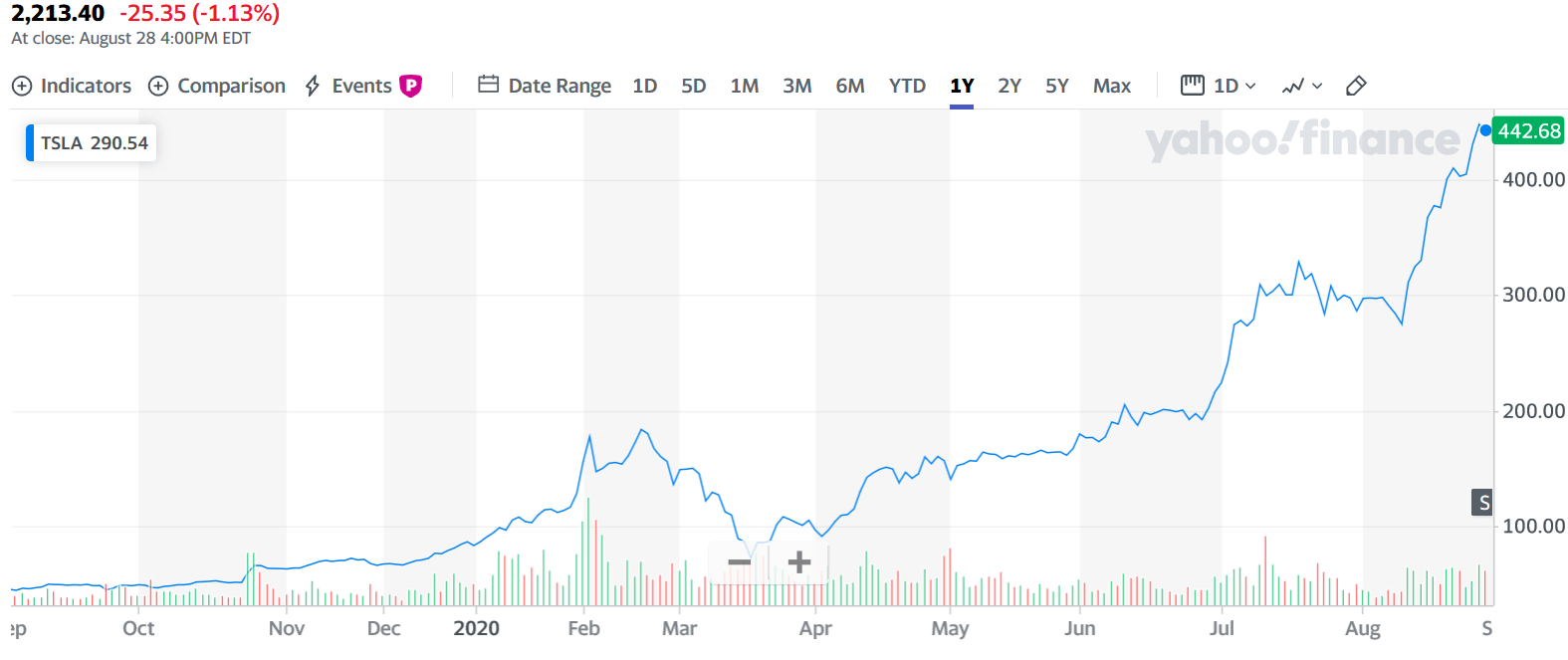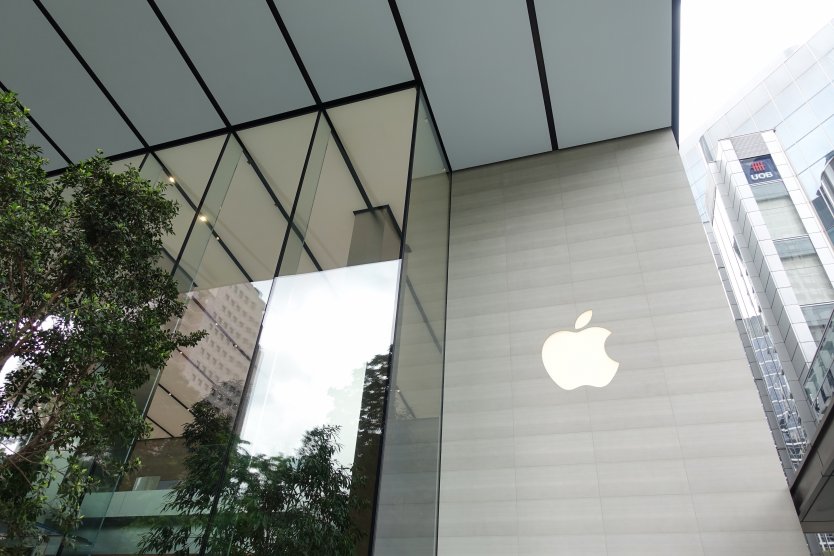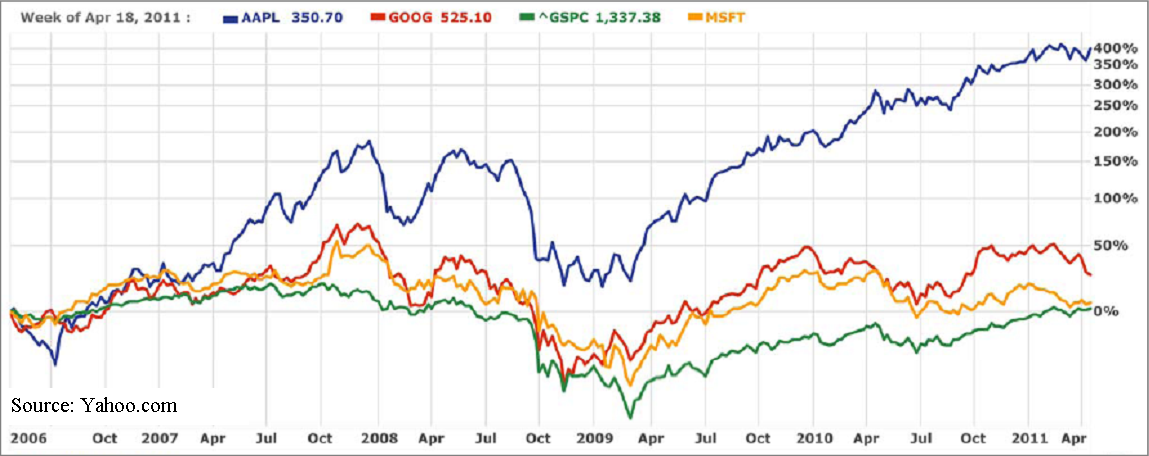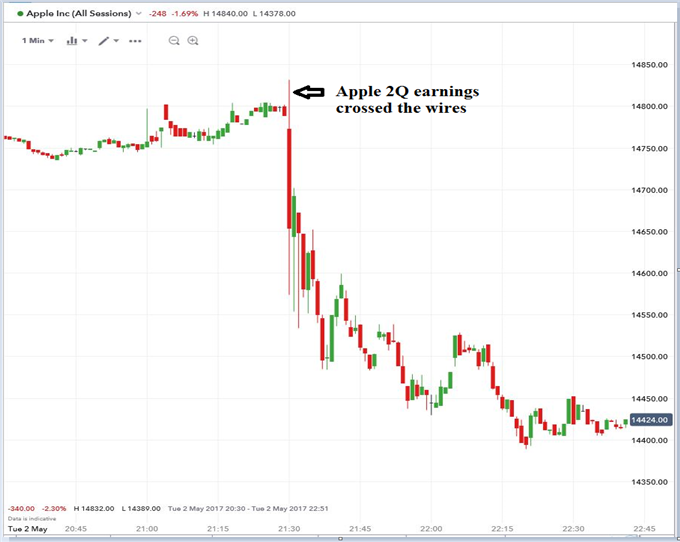The second Apple stock split took place on 21 June 2000, and was also a two-for-one split. Ahead of the split in May 2000, the stock price was $84. Shortly afterwards though, in September 2000, share prices were halved as many technology companies experienced a rapid decline. This was around the time the dot-com bubble burst, where many companies went out of business and others decreased in value.
Apple blamed lower-than-forecast sales, as well as a weaknesses in the education market. While Apple was affected temporarily, the company's shares made a full recovery and went on to achieve new highs. Apple's split didn't affect its weighting in the S&P 500, MSCI World Index or any other index based on market capitalization—the total dollar value of all outstanding shares. This is logical, because a stock split doesn't affect the company's market capitalization, either.
It just spreads that market value across a larger pool of shares. The number of shares held by an individual investor changes, but the total dollar value of those shares doesn't. The Dow, however, doesn't weight its constituents according to their market size.
Before Apple split, its share price of $503 as of August 24 made it the Dow's largest constituent. After the split and the reshuffle, Apple fell to the middle of the pack, greatly reducing its influence on the index's return—even as its influence on cap-weighted indexes didn't waver. In Fisher Investments' view, the latter is more relevant for investors, as portfolio holdings are inherently cap-weighted. An investor's portfolio performance depends on the percentage of their portfolio, in dollar terms, represented by each company—irrespective of share price. Investing in stock markets involves the risk of loss and there is no guarantee that all or any capital invested will be repaid.
Past performance is no guarantee of future returns. International currency fluctuations may result in a higher or lower investment return. This document constitutes the general views of Fisher Investments and should not be regarded as personalized investment or tax advice or as a representation of its performance or that of its clients. No assurances are made that Fisher Investments will continue to hold these views, which may change at any time based on new information, analysis or reconsideration. In addition, no assurances are made regarding the accuracy of any forecast made herein.
Not all past forecasts have been, nor future forecasts will be, as accurate as any contained herein. Apple's fourth and final stock split to date happened on 9 June 2014. This was the most significant of Apple's stock splits, with a seven-to-one ratio taking shares from close to $700 down to around $100. Apple wanted to make shares accessible to more investors, but it's also speculated that they set their sights on inclusion in the Dow Jones Industrial Average index. This index acts as a benchmark, with 30 stocks included from key economic sectors.
As it's a price weighted average, Apple's stock price needed to be reduced before it was feasible for the company to be added. It was announced that Apple would join the Dow Jones in March 2015 and it has been a part of the index since March 2019. It seems unlikely that Apple will complete another stock divide in the near future. Share prices are still climbing (they are currently trading at around $186), however shares were worth close to $700 before the last split in 2014. Apple may consider another stock split if share prices continue to rise, but for now, this move probably wouldn't be in the best interests of the company.
Apple's first stock split occurred on 16 June 1987, seven years after it became a public company, and it was a two-for-one stock split. It kept share prices low enough to make them accessible to investors. There was a 2% rise in stock prices over the following year. When looking at the value of a company's shares, it can be difficult to interpret how successful the company has been based on its stock prices following a split. Apple's current share price of around $408 doesn't look as impressive as it would have done ahead of its four stock splits.
In addition, it would be interesting to incorporate sentiment analysis on news and social media regarding the stock market in general, as well as a given stock of interest. Another promising approach for better stock price predictions is the hybrid model, where we add MA predictions as input vectors to the LSTM model. You might want to explore different methodologies, too.
MarketBeat empowers individual investors to make better trading decisions by providing real-time financial data and objective market analysis. According to AllForecast's predictions, we're likely to see very low levels of volatility in two years' time. The monthly percentage changes are relatively consistent — although four months will see the stock price drop slightly, the overall trend is modestly bullish. It's unlikely to pave the way for the heights predicted for 2025 by AI Pickup, but it's still a significant increase from its current price of $117.03. Certainly, all kind of factors can influence a company's performance, be it market crash or a new product launch and stock split is also one of those factors.
They create short term blips but they cannot create long term effect and revenue or good profit margins can only push stock in long term. Apple has been a massive winner for patient investors because the company has strong leadership and is continually innovating. Investors who bought after the COVID pandemic induced downfall, they have been rewarded handsomely. History has been repeated for Apple stock as similar kind of saga unfolded after 2000 dot com induced crash.
September is always an exciting month for Apple users and investors as the company readies for the latest instalment in its flagship iPhone line. While this should not have any effect on the stock price for Apple, it could potentially have an impact on quarterly revenues when they are announced at the end of October. It seems that a stock split may not automatically result in benefits for investors who bought the split share at lower price. Apple's financial performance, including its share price, relies heavily on the sales of its products. But the two haven't necessarily gone hand in hand.
A high flier through much of its recent history, Apple stock hit new all-time highs toward the end of 2021, with a market capitalization approaching a record $3 trillion. Dow Jones Industrial average has had many companies in and out over its 136 years' life but Apple's 4-for-1 stock split had rather unusual effect on Dow Jones. As, S&P 500 and MSCI World Index takes the weight of a stock based on its market capitalization, Apple's split did not have much effect on the index. The Dow, instead of using constituents market capitalization, it uses share's share price. It began publicly trading on Dec 12, 1980 and this is the fifth split. Here is a history of Apple's previous splits and its after effects.
The online retail juggernaut has one of the most expensive stock prices on the market today at $3,310 a share. And the company hasn't split its stock since 1999 at the height of the tech bubble. Retail investors are clamoring for AMZN to finally split its stock and make it more affordable for individuals to take a position. Stock divides might not directly increase share prices, but they can often result in higher share prices further down the line. By making shares accessible to new investors, demand can increase, causing the share price to appreciate and the total market capitalisation to rise.
The company has previously split its stock four times when its shares have seen significant price increases, as highlighted in the table below. In the first three instances, stocks were split in two when the price was near triple figures. Then, in 2014, share prices rose sharply and a higher split ratio was used. The stock market is known for being volatile, dynamic, and nonlinear. Accurate stock price prediction is extremely challenging because of multiple factors, such as politics, global economic conditions, unexpected events, a company's financial performance, and so on.
Home improvement retailer Home Depot Inc. reported its fourth-quarter results Tuesday morning and beat earnings and revenue forecasts, but traders were sellers of the stock at the open. Let's take a fresh look at the charts and indicators of Home Depot. The trading volume has been heavier the past three months as traders and investors appear to be voting with their feet.
A longer-term Wall Street bull case for Apple shares is being built on belief in improving business fundamentals. To be clear, stock splits do not change a company's underlying fundamentals. And though the lower-priced shares can attract smaller investors, larger investors already trading the shares can maintain more influence over the price action. The overall market environment is key, as well, and it has influenced trading after the limited number of previous Apple stock splits. Apple is having a great year, and its4-for-1 stock spliton Monday is expected to make the market's most-valuable company even more attractive to a wider universe of retail investors.
But the limited history of Apple stock splits says there is no reason to rush in to buy the lower-priced shares. Silverblatt said companies traditionally courted more retail investors because they were loyal "buy and hold forever" types – which can lend stability to share prices. If that's Apple's strategy, the company is hoping the 4-for-1 split at the end of the month will put a solid floor under its shares at around $100 that would lock in shareholder gains in 2020.
Apple Stock Price Forecast After Split Our final short-term Apple stock price prediction comes from the investment bank Goldman Sachs. In contrast to the sky-high forecasts from CNN Money and WalletInvestor, Goldman Sachs has a much more bearish prediction — and has ultimately given a sell rating for the stock. With Apple's stock price continuing to rise, it should be no surprise to anyone if we see a $3 trillion market cap at some point in 2021. Historically after Apple has split its stock, the return for the following year has outpaced the performance of the S&P 500 considerably with the exception of the dot-com collapse in 2000. Every other split has far exceeded the rest of the market – which could mean another healthy year for investors as the S&P has already returned 20% over the past twelve months.
Apple stock price forecast seems to be on a lot of investors' minds - over the last few years, it has been one of the top stocks to trade. While many agree that Apple has good revenue growth prospects, reflecting its long-term sustainable competitive advantages, there is a lot to talk about. This surging trend points to Apple taking advantage of 5G technologies, offering users with superbly faster download times and allow a vast array of advanced technologies. The iPhone sales have also strengthened demand for Apple's array of services. Such high-margin revenue streams would then fuel the tech giant's impressive earnings growth.
Bullish investors are definitely excited about the possibility of greater profits, which beefed up Apple's stock performance that has reached all-time highs. How should an investor react to this corporate announcement? We give you a lowdown on different aspects of stock-splits. Transactions in the international currency market Forex contain a high level of risk. Only speculate with money that you can afford to lose. All stock prices, indices, futures are indicative and should not rely on trade.
The portal allforecast.com does not accept any liability for any loss that you may incur as a result of using this data. An investor buys a share in Apple in January 2005, so they have one share worth $77.00. After the two-for-one stock split a month later, they own two shares in Apple, but each of these shares is worth half the amount, at $38.50. If the shareholder keeps these two stocks until May 2014, they will be worth $1,266 ($633 each) as the stock price appreciates. With the fourth stock split, each of these stocks will then be split seven times, so that the shareholder owns 14 shares in Apple. Now would seem to be a lousy time to buy Apple stock.
Anxious about negative iPhone sales reports, Wall Street analysts are stumbling over each other to downgrade the stock and chop their price targets. But those analysts are missing something crucial about the company - something that will drive the AAPL stock price to $300 by 2020. Apple Inc stock price live 164.90, this page displays NASDAQ stock exchange data.
View the AAPL premarket stock price ahead of the market session or assess the after hours quote. Monitor the latest movements within the Apple Inc real time stock price chart below. You can find more details by visiting the additional pages to view historical data, charts, latest news, analysis or visit the forum to view opinions on the AAPL quote. We've seen the advantage of LSTMs in the example of predicting Apple stock prices compared to traditional MA models. Be careful about making generalizations to other stocks, because, unlike other stationary time series, stock market data is less-to-none seasonal and more chaotic. Weeks after Apple reached all-time highs based on a hyped Apple Car, an influential analyst hiked their price target for the stock to $200 based on another hyped product.
The stock remains priced for perfection in a market where lesser companies have already reached bear market levels. My investment thesis on Apple remains Bearish, as the stock continues to rise on hyped products years away with no guarantee for success. Large companies beat collective market expectations of their earnings to positively influence their market capitalization. That they often manipulate their earnings reports to match or beat estimates to artificially enhance their stock prices is no accident.
As a result, the Securities and Exchange Commission intensely scrutinizes earnings management. Apple stock price is up by more than 33% in last one year. As stock price have soared, key valuations metrics have also skyrocketed to their highest levels in more than a decade. Company's price to earnings, price to sales and price to free cash flow ratios all remain much higher than their five years' average. Today's P/E is roughly 30, while five years' average is nearly 20, Apple needs to grow at steady rate or the share price could fall further.
In the quarter following the split, shares were up three out of five times. In 2000 and 1987, stock climbed more than 20%, eluding market collapses that were about to come. In contrast, quarters in 2020, 2014 and 2005 were decently bad, but stock was about to give good return in a matter of time. As we can see in the price chart above, the maximum Apple stock price prediction reported by CNN Money is $150.
This would be a growth rate of 29.3%, smashing its previous ATH. Although the potential low is much more bearish (it clocks in at just $74.10), the CNN analysts agree that the AAPL stock is a strong buy — and they're not alone. Short-term forecasts by analysts predict an increase next year. Also, long-term predictions generated from historical data share the same positive sentiment. It's safe to say that there is no projected explosive growth, but it will be consistent.
With this enticing trend, as Apple continues to beat analyst estimates for earnings, the current quarter would not be an exception. The EPS trend remains on the rise in analysts' view. As a result, money should continue to add up in the AAPL stock coffers and reach all-time highs.
These would lead to more bullish activity in the near-term. However, the rest of the stocks gave negative returns. Apple's third stock split took place on 28 February 2005, with the company once again allocating a two-for-one ratio. This took the number of common shares authorised from 900 million to 1.8 billion, after shares almost quadrupled in value. Public company stocks tend to go up after an earnings report if revenues and earnings growth are higher than what investors expect and it raises its forecast for the current quarter's results. Apple beat expectations for its June-ending quarter and declined to provide a forecast for the second quarter in a row.






























No comments:
Post a Comment
Note: Only a member of this blog may post a comment.